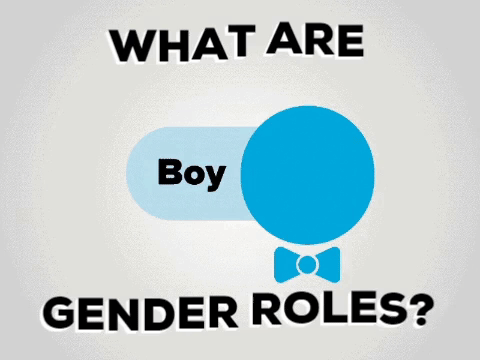Gender Roles and Gender Identities

In this post, we shall be looking at socially constructed roles and identities regarding both sexes.
First of all, what is Identity? And why is it so important in shaping who we are?
Identity is the fact of being of a person, however, it isn’t simply just that, but much more. Identity is all about how individuals or groups see themselves and how individuals or groups see and define them. As Jenkins (2008) puts it; ‘’Identity involves knowing who we are, knowing who others are, them knowing who we are, us knowing who we think they are, and so on.’’
An important thing one must take note of is that identity is something which is socially caused and therefore, it is not the same as personality, which refers to the psychological aspects of a person’s character. Personality tends to be fixed, whereas identity tends to be more fluid and changeable. Identity is something which rests on the idea of marking out similarities with as well as differences from others. For instance, we share identities which make us similar to others such as being human, being a man or a woman, belonging to a particular ethnic group etc., but it also involves a personal notion and that is our individual uniqueness. Lawler (2014) points out that if we did not have an Identity, we would not be able to recognize who we are and who others are. If we hadn’t an identity, we wouldn’t be able to maneuver or integrate with others, we wouldn’t be able to form a part of society or contribute to society as well as benefit from society as individuals.
Experts such as Mead (1934) referred to this as ‘I’ or the ‘real me’ and some may say that it exists beyond social influences. He recognized it as ‘the self is something which has a development; it isn’t initially there at birth but arises in the process of social experience and activity.’ We now know that identity is something that we adopt once we begin to go through life.

Because identity of individuals and groups involves personal choice as well as behavioral attitudes and responses according to others, we learn that identity isn’t simply a matter of choice alone. What others may think of us and how others may see us also affects the identities we choose to adopt. The identity one may want to assert and that which they may want others to see them having may not be the one that others will accept or recognize.
Sociologist Becker (1963[1997]) called this a master-status. A master-status refers to the dominant status or identity of the individual which overrides all other aspects of that same individual’s identity.
Often times, one may not wish to be identified primarily as belonging to a particular sex or ethnicity, but may perhaps want to be seen as a senior Manager or Entertainer, for example. In addition to this, if others continue to see them in terms of their master-status, that individual may find it very difficult to assert their chosen identity. Individuals have multiple identities leading them to asserting different identities in different circumstances. Among those multiple identities are certain identities and roles which are chosen not by us, but by society itself. One of those selected roles are Gender Roles.

Gender roles are socially constructed roles which involve a range of behaviors and attitudes that are expected from each member of society depending on their biological sex. As individuals begin to grow, they begin to learn different habits, norms and values from family and community which serve as agencies of primary socialization. It is here that traditional gender roles first emerge as each member of the family raises their children on the basis of these roles which were passed on from generation to generation through the socialization process.
Our sexual orientation is not the same as gender. Our ‘sex’ refers to our biological differences and our ‘gender’ refers to the roles that we are expected to conform to according to our sex. This tells us that male and female identities and roles based on our biological sex can actually be changed because they were once created by society as a way to balance out the asserted behaviors in order to maintain an equilibrium in society. Men’s role was a public role which involved taking care of the family, working for the family, holding high positions of work and women’s role was found in the private realm which involved taking care of their children if they have any, learning how to cook and clean, taking care of the house and so on. There are different approaches to these roles and some argue that these roles are very wrong and have taken for granted the importance of gender, ethnicity, race etc.

Functionalist Perspective on Gender
Structural functionalism understands human behavior as part of systems that help keep society organized and functioning. Gender is a way of organizing society into distinct roles that complement each other. Some Anthropologists have argued that hunter-gatherer societies originated the idea that men are providers and women take care of the home. Men were considered to be physically stronger than women and weren’t the ones who bore children into the world which helped make it easier for them to take more aggressive roles like hunting and warfare, therefore these roles became institutionalized. Although physical strength was no longer of importance for many jobs, it was taken for granted that men would be the providers and women would care for their young ones and do the housework.
However, this theory has misconceptions, mainly because the early Anthropologist who studied this dynamic, overemphasized the role of things. More recent Anthropological works suggest that gathering, fishing and hunting- all which were performed by women too – played an important and much larger role in providing necessities in these societies.
But the idea of having two gender roles remained existent, partially through the work of sociologist Talcott Parsons. He argued that boys and girls are socialized to take on traits that are complementary to one other to make it much easier to maintain stable productive family units. Parsons said that boys are taught what he referred to as ‘instrumental qualities’ such as confidence and competitiveness that prepares them for the labour they are expected to do. Meanwhile, girls are taught what Parsons called ‘expressive qualities’, such as empathy and sensitivity, which ultimately prepares them to care for their families. Parsons’ Theory was that a successful family needs people to have complementary sets of skills and gender was a way of pairing off these skills. Moreover, society in turn encourages gender conformity by making people feel like they have to fit these roles which are expected of them by all those around them especially if they want to be desirable in any way. Also, by teaching people to reject those who go against these established gender norms and values. This theory was a particularly influential one in the mid 20th Century, however, it has fallen out of favor in recent times.
The reasons to this are:
-Parsons was basing his theory on a division of labour that was specific to middle-class white America in the late 1940s and 1950s. This assumes a heteronormative (relating to a world view that promotes heterosexuality as the normal or preferred sexual orientation) and western perspective on what a family is; not all families are nuclear meaning derived of one man, one woman and their children. It is only in the present times that we have learned that there is no singular definition to family as there exists many different kinds of families.
We may now expand the definition of a family by including same sex couples, single parents, small generational families or even childless adults, it is less obvious that one should assume that a man works ‘outside home’ and a woman works ‘inside home’
The idea of complimentary gender roles emphasizes on there being two distinctively opposite genders, this is a western perspective. The idea of gender being composed of two different things is not universal. Critics argue that men needing to be the ones working outside the home to maintain family stability is arbitrary (meaning that it is based on individual preference) and reinforces gender dynamics which give men power and dominance over women.
Social Conflict Theory regarding Gender
According to conflict Theorists, Gender is a structural system that distributes power and privilege to some and disadvantage to others. It argues that social problems are created when dominant groups exploit or oppress subordinate groups. The structural system as mentioned above is the Patriarchal system; a form of social organization in which men have more power and dominance over other genders. Examples of this structure may be seen in restricting higher education or limiting the choices and opportunities for work positions to men only. Women are stereotyped as more emotional and men are stereotyped as more rational, which makes people falsely consider women to be weak and see men as more natural fits for leadership positions. With this being said, it is also important to mention that the way that patriarchy privileges certain people over others also isn’t simple as saying that all men are at the top of the power distribution.
While all women are disadvantaged by their gender, it’s also true that some women experience more disadvantage than others. The same disadvantages may be seen for men as all men benefit from a society that privileges masculinity, but some benefit more than others and these inequalities one may be able to realize that these disadvantages can stack up on top of one another.
Farrington and Chertok (1993) said that It is difficult for women to rise above men, as dominant group members create the rules for success and opportunity in society.
Feminist Approach on Gender
To give brief definition of the word itself, feminism refers to a range of political movements and ideologies that all have one main goal, that is, to construct, establish and achieve political, economic, social (as well as individual and personal) equality for both sexes. This emphasizes on the firm importance of establishing educational and professional choices and opportunities for women that are equivalent to those for the men. It uses the conflict approach to examine the maintenance of gender roles and inequalities. In broader speech, feminism advocates the elimination of gender stratification, expanding the choices that women, men and other genders are allowed to make, ending gender-based violence and promoting sexual freedom. There are a number of different movements of feminist ideologies and these have developed and emerged overtime. They may vary in targets, strategies and affiliations and they tend to converge. Moreover, many feminists identify with numerous branches of feminist theories and thoughts.
Some major schools of thought within feminism are:
- Socialist Feminist: This views capitalism as the foundation of the patriarchy and advocates for full economic equality in the socialist trade.
-Radical Feminism: This branch of feminism suggests that to reach gender equality, society must eliminate gender as we know it. Many radical feminists refuse to acknowledge the gender identities of trans women and have accused the trans gender movement of perpetuating patriarchal gender norms. These ways of thinking about feminism are only a few of the many views on how to best advocate for gender and many different branches expand on many different issues related to gender stratification.
Symbolic Interactionist Approach
This approach aims to understand human behavior by analyzing the critical role of symbols in human interaction. This is most definitely relevant to the discussion of masculinity and femininity because while structural functionalists are concerned with how gender helps all of society work well, symbolic interactionists are more focused on gender as a part of day-to-day life. Because the meanings attached to symbols are socially created and not ‘natural’ or fluid, from this perspective we see that gender is something a person does, rather than being something which is imposed by institutions. Clothes, hairstyles and make-up all telegraph gender those around you. When people perform tasks or possess characteristics based on the gender role assigned to them, they are said to be doing gender. West and Zimmerman (1987) argue that whether we are expressing our masculinity or femininity we are always “doing gender.” Thus, gender is something we do or perform, not something we are. In other words, both gender and sexuality are socially constructed. The social construction of sexuality refers to the way in which socially created definitions about the cultural appropriateness of sex-linked behavior shape the way people see and experience sexuality. Moreover, many forms of intimacy may be considered as deviant sexual acts such as pedophilia, sado-masochism(sex involving intense painful acts, such as lashing), transvestism (cross dressing), necrophilia (engaging in intercourse with dead bodies). This results into the fear and pressure of carrying a stigmatized or spoiled identity and forever having it form a part of their public identity that people conceal such forms of sexuality-what Goffman referred to as ‘impression management-which do not conform with normal sex.
Quote of the day!

Comments



